Humanity has long been fascinated and inquisitive about the immense expanse of space. Throughout the years, our pursuit of comprehending the universe has compelled us to dispatch numerous spacecraft beyond the boundaries of our planet and into the vast expanses of the solar system and beyond. These extraordinary expeditions not only represent our cleverness and the unwavering quest for understanding but also yield priceless information about the cosmos that envelop us.
This article explores the extremely good trips of the five furthest spacecraft, each marking a considerable achievement in area tour. These probes, which have been launched through several area companies over the previous few many years, have traversed billions of kilometers away from Earth, exploring uncharted territories that no man-made object has ever reached. By analyzing their objectives, accomplishments, and gift circumstance, we collect valuable understanding about the big and on occasion surprising breakthroughs they have got enabled, essentially altering our comprehension of the cosmos and the passage of time.
From the groundbreaking missions of the 1970s to the more recent undertakings, this document will guide you through the frigid, obscure, and enigmatic of space, where these silent pioneers persist in their solitary expeditions, transmitting fragments of the universe’s enigmas. Join us as we examine the five farthest spacecraft in space and admire the cleverness that drives humanity’s aspirations toward the stars.
Understanding Spacecraft and Their Missions
Definition of Spacecraft
A spacecraft is a vehicle or machine designed for travel or operation in outer space. These sophisticated devices are equipped with various instruments and systems that enable them to navigate through the vacuum of space, collect data, and communicate with Earth. Spacecraft come in different shapes and sizes, ranging from small cubes to large probes and rovers.
Types of Space Missions
Space missions encompass a wide range of objectives, from scientific exploration to technological demonstrations and satellite deployments. Some common types of space missions include:
- Scientific Exploration: These missions are primarily focused on advancing our understanding of the universe. They often involve studying celestial bodies such as planets, moons, asteroids, and comets to uncover their geological, atmospheric, and biological characteristics.
- Technology Demonstrations: Space agencies frequently conduct missions to test new technologies and engineering concepts in the harsh environment of space. These demonstrations pave the way for future advancements in spacecraft design, propulsion systems, and instrumentation.
- Satellite Deployments: Many space missions involve launching satellites into orbit around Earth or other celestial bodies. These satellites serve various purposes, including communication, navigation, Earth observation, and scientific research.
- Interplanetary Exploration: Interplanetary missions involve sending spacecraft to explore other planets and moons within our solar system. These missions provide valuable insights into the geology, climate, and potential for life on other worlds.
- Astrophysical Observations: Space telescopes and observatories are deployed to study distant stars, galaxies, and cosmic phenomena. These missions help astronomers unravel the mysteries of the universe and expand our knowledge of its origins and evolution.

Key Objectives of Distant Spacecraft
Distant spacecraft, particularly those venturing far beyond the confines of our solar system, are tasked with achieving specific objectives that contribute to our understanding of space and the cosmos. Some key objectives of these missions include:
- Exploring Outer Solar System: Distant spacecraft are often sent to explore the outer regions of our solar system, including the gas giants Jupiter, Saturn, Uranus, and Neptune, as well as their moons and surrounding environments.
- Studying Interstellar Space: Certain spacecraft are designed to travel beyond the boundaries of our solar system and into interstellar space. These missions aim to study the space between stars, investigate cosmic rays, and search for signs of interstellar material.
- Measuring Cosmic Radiation: Distant spacecraft equipped with radiation detectors play a crucial role in measuring cosmic rays and other high-energy particles that originate from sources such as supernovae, black holes, and active galactic nuclei.
- Mapping Magnetic Fields: Some distant spacecraft are equipped with instruments for mapping the magnetic fields of distant planets, moons, and interstellar space. These measurements provide insights into the dynamics of planetary interiors and the interactions between celestial bodies and their surrounding environments.
- Monitoring Solar Wind: Spacecraft positioned far from Earth can provide valuable data on the solar wind, a stream of charged particles emanating from the Sun. By studying the properties and behavior of the solar wind in the outer solar system, scientists can better understand its impact on planetary atmospheres and space weather.
Criteria for Ranking the Most Distant Spacecraft
Distance Measurement Methods
Determining the distance of spacecraft in space involves sophisticated methods and technologies. Some common distance measurement methods include:
- Radio Tracking: Spacecraft emit radio signals that are received by antennas on Earth. By measuring the time it takes for the signal to travel between the spacecraft and Earth, scientists can calculate the distance with high precision.
- Doppler Shift: Changes in the frequency of radio signals emitted by spacecraft can be used to measure their relative velocity and distance. This method, known as Doppler tracking, is particularly useful for determining spacecraft velocities and trajectories.
- Light-Time Delay: When spacecraft transmit signals to Earth, there is a delay due to the finite speed of light. By measuring the time it takes for signals to travel between the spacecraft and Earth, astronomers can calculate the distance based on the speed of light.
Mission Duration and Achievements
The duration of a spacecraft’s mission and its achievements are key factors in determining its ranking as one of the most distant. Mission duration reflects the spacecraft’s ability to withstand the harsh conditions of space and continue operating effectively over extended periods. Achievements may include scientific discoveries, successful instrument deployments, and groundbreaking observations that contribute to our understanding of the cosmos.
Current Status and Communication
The current status of a spacecraft and its communication capabilities are crucial for assessing its operational status and ability to relay data back to Earth. Spacecraft often rely on radio communication systems to transmit data, commands, and status updates to mission control centers on Earth. Factors such as power supply, onboard systems, and antenna orientation affect a spacecraft’s ability to maintain communication over vast distances. Additionally, the availability of ground-based tracking stations and the efficiency of communication protocols play a vital role in ensuring seamless communication between spacecraft and mission control.
The Top 5 Most Distant Spacecraft
Voyager 1
Mission Overview
Launched by NASA on September 5, 1977, Voyager 1 is one of the most iconic and enduring spacecraft in human history. Its primary mission was to conduct close-up studies of Jupiter and Saturn, including their moons and rings, as part of NASA’s Voyager program. After completing its primary mission objectives, Voyager 1 continued its journey outward from the solar system, becoming the first spacecraft to reach interstellar space.
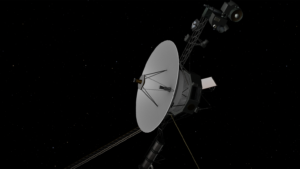
Current Distance from Earth
As of May 25, 2024, Voyager 1 holds the record for being the most distant human-made object from Earth. Its current distance from Earth is approximately 24,343,373,111 kilometers, equivalent to 162.725398 Astronomical Units. Despite its immense distance, Voyager 1 continues to transmit data back to Earth, providing valuable insights into the outer reaches of the solar system and beyond.
Scientific Discoveries
Throughout its decades-long journey, Voyager 1 has made numerous groundbreaking scientific discoveries:
- Jupiter and Saturn Exploration: Voyager 1 provided unprecedented close-up views of Jupiter and Saturn, revealing intricate details about their atmospheres, moons, and ring systems. These observations revolutionized our understanding of these gas giants and their diverse moons, including the discovery of active volcanoes on Jupiter’s moon Io.
- Interstellar Medium: In 2012, Voyager 1 crossed the boundary of the heliosphere, entering interstellar space—the region between stars. Its instruments continue to study the properties of the interstellar medium, including cosmic rays, magnetic fields, and plasma density, shedding light on the dynamics of the galactic environment.
- Golden Record: Voyager 1 carries a Golden Record—a phonograph record containing sounds and images selected to portray the diversity of life and culture on Earth. Intended as a message to any extraterrestrial civilizations that may encounter the spacecraft, the Golden Record represents a unique cultural artifact.
Status and Future Projections
Despite its remarkable longevity, Voyager 1’s primary power sources—its radioisotope thermoelectric generators (RTGs)—are gradually declining in output. Eventually, the spacecraft’s instruments will cease to function, and communication with Earth will be lost. However, Voyager 1’s trajectory will carry it onward through the vastness of space for millions of years, potentially encountering other star systems in the distant future. Its legacy as a pioneer of interstellar exploration will endure for generations to come.
Voyager 2
Mission Overview
Launched by NASA on August 20, 1977, just a few weeks before its twin spacecraft Voyager 1, Voyager 2 embarked on a similar mission to explore the outer planets of our solar system. Its primary objectives included close-up studies of Jupiter, Saturn, Uranus, and Neptune, as well as their moons and ring systems. Voyager 2 provided unprecedented insights into the dynamics and diversity of these distant worlds, significantly expanding our knowledge of the outer solar system.
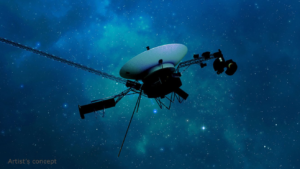
Current Distance from Earth
As of May 25, 2024, Voyager 2 continues its journey through interstellar space, marking another milestone in human space exploration. Its current distance from Earth is approximately 20,355,970,951 kilometers, making it one of the most distant human-made objects in the universe. Despite its vast distance, Voyager 2 remains in communication with Earth, transmitting data back to scientists for analysis and study.
Scientific Discoveries
Voyager 2’s extensive mission yielded a wealth of scientific discoveries, including:
- Planetary Exploration: Voyager 2 conducted close flybys of Jupiter, Saturn, Uranus, and Neptune, capturing high-resolution images and data about these gas giants and their moons. Among its many discoveries were the active volcanoes on Jupiter’s moon Io, the complex ring systems of Saturn and Neptune, and the dynamic atmospheres of Uranus and Neptune.
- Heliosphere Boundary: Like its twin Voyager 1, Voyager 2 crossed the boundary of the heliosphere and entered interstellar space. Its instruments continue to study the properties of the interstellar medium, providing valuable insights into the environment beyond the influence of the Sun.
- Solar System’s Structure: Voyager 2’s trajectory allowed it to provide detailed observations of the outer planets and their interactions with the solar wind. These observations helped scientists understand the structure and dynamics of our solar system, including the influence of the Sun’s magnetic field on distant worlds.
Status and Future Projections
Voyager 2’s instruments continue to operate despite being more than four decades into its mission. However, like Voyager 1, its power sources are gradually diminishing, and its scientific capabilities will eventually decline. Nevertheless, Voyager 2’s trajectory will carry it onward through interstellar space for millions of years, providing a lasting testament to humanity’s curiosity and ingenuity. Its ongoing mission serves as a reminder of the enduring legacy of the Voyager program and the spirit of exploration that drives humanity to explore the unknown.
New Horizons
Mission Overview
Launched by NASA on January 19, 2006, New Horizons is a spacecraft designed to explore the outer regions of our solar system, particularly the dwarf planet Pluto and its moons. The mission aimed to provide the first close-up images and scientific data of Pluto and its moons, shedding light on these distant and mysterious worlds. After its historic flyby of Pluto in July 2015, New Horizons continued its journey into the Kuiper Belt, where it encountered other objects of interest.
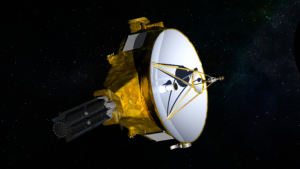
Current Distance from Earth
As of May 25, 2024, New Horizons continues its voyage through the outer solar system, exploring the Kuiper Belt and beyond. Its current distance from Earth is approximately 8,714,532,373 kilometers, placing it among the most distant spacecraft launched by humanity. Despite its vast distance, New Horizons remains in communication with Earth, transmitting data back to scientists for analysis and study.
Scientific Discoveries
New Horizons’ mission to Pluto and the Kuiper Belt has resulted in numerous groundbreaking scientific discoveries, including:
- Pluto Flyby: New Horizons conducted a historic flyby of Pluto on July 14, 2015, providing the first detailed images and data of the distant dwarf planet. These observations revealed a complex and dynamic world with mountains, glaciers, and a thin atmosphere, challenging scientists’ previous assumptions about Pluto’s geology and composition.
- Kuiper Belt Exploration: After its Pluto flyby, New Horizons continued its journey into the Kuiper Belt, where it encountered the Kuiper Belt Object (KBO) Arrokoth (formerly known as Ultima Thule). Close-up observations of Arrokoth provided insights into the formation and evolution of primitive bodies in the outer solar system, offering clues about the early history of our solar system.
- Beyond the Solar System: New Horizons’ trajectory carries it toward the outer edges of the solar system and into interstellar space. Its instruments continue to study the environment of the Kuiper Belt and beyond, providing valuable data on the structure and dynamics of the outer regions of our solar system.
Status and Future Projections
New Horizons continues to operate nominally, with its instruments functioning as expected. While its primary mission objectives have been achieved, scientists continue to analyze the wealth of data collected during its flybys of Pluto and Arrokoth. Future projections for New Horizons include the possibility of encountering other Kuiper Belt Objects and continuing its journey into interstellar space, providing valuable insights into the outer reaches of our solar system and beyond.
Pioneer 10
Mission Overview
Launched by NASA on March 2, 1972, Pioneer 10 was the first spacecraft to venture beyond the asteroid belt and explore the outer regions of our solar system. Its primary mission objectives included studying the asteroid belt, Jupiter, and its moons. Pioneer 10 provided valuable data about Jupiter’s magnetosphere, radiation belts, and atmosphere, paving the way for future missions to the gas giant.
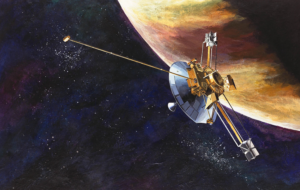
Current Distance from Earth
Pioneer 10’s last communication with Earth was received on January 23, 2003. As of that date, its distance from Earth was approximately 20,494,786,411 kilometers. Despite losing contact with the spacecraft, its trajectory continues to carry it away from the Sun and deeper into interstellar space.
Scientific Discoveries
Pioneer 10’s mission yielded several significant scientific discoveries, including:
- Jupiter Exploration: Pioneer 10 conducted the first flyby of Jupiter in December 1973, providing the first close-up images and scientific data of the gas giant and its moons. The spacecraft’s observations helped scientists better understand Jupiter’s atmosphere, magnetic field, and radiation environment.
- Asteroid Belt Studies: Before reaching Jupiter, Pioneer 10 passed through the asteroid belt between Mars and Jupiter, providing valuable data about the distribution and composition of asteroids in this region.
- Cosmic Ray Investigations: Pioneer 10 carried instruments for studying cosmic rays, giving valuable insights into the radiation environment beyond Earth’s magnetosphere.
Status and Future Projections
Pioneer 10’s mission officially ended on March 31, 1997, when it was decommissioned by NASA. Despite losing contact with the spacecraft, Pioneer 10 continues its journey through interstellar space, carrying a plaque designed to communicate information about humanity to potential extraterrestrial civilizations. Future projections for Pioneer 10 involve its continued drift through the Milky Way galaxy, serving as a silent ambassador of human exploration and curiosity.
Pioneer 11
Mission Overview
Launched by NASA on April 5, 1973, Pioneer 11 followed in the footsteps of its predecessor, Pioneer 10, to explore the outer regions of our solar system. Its primary mission objectives included studying Jupiter and its moons, as well as conducting a flyby of Saturn. Pioneer 11 provided valuable data about the gas giants and their environments, expanding our understanding of the outer solar system.
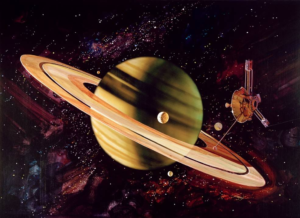
Current Distance from Earth
Pioneer 11’s last communication with Earth was received on November 24, 1995. As of that date, its distance from Earth was approximately 12 billion kilometers (about 7.5 billion miles). Like its twin spacecraft, Pioneer 10, Pioneer 11 continues its journey away from the Sun and deeper into interstellar space.
Scientific Discoveries
Pioneer 11’s mission led to several significant scientific discoveries, including:
- Jupiter Exploration: Pioneer 11 conducted a flyby of Jupiter in December 1974, providing valuable data about the gas giant’s atmosphere, magnetosphere, and radiation belts. The spacecraft’s observations complemented those of its predecessor, Pioneer 10, helping scientists build a comprehensive picture of Jupiter and its moons.
- Saturn Flyby: After its encounter with Jupiter, Pioneer 11 continued its journey toward Saturn, conducting a successful flyby of the ringed planet in September 1979. The spacecraft provided the first close-up images and scientific data of Saturn and its rings, shedding light on their composition, structure, and dynamics.
- Heliosphere Boundary: Pioneer 11 crossed the boundary of the heliosphere—the region of space influenced by the Sun’s solar wind—providing valuable insights into the structure and dynamics of this region.
Status and Future Projections
Pioneer 11’s mission officially ended on September 30, 1995, when it was decommissioned by NASA. Despite losing contact with the spacecraft, Pioneer 11 continues its journey through interstellar space, carrying a plaque similar to the one aboard Pioneer 10. Future projections for Pioneer 11 involve its continued drift through the Milky Way galaxy, serving as a silent testament to humanity’s exploration of the cosmos.
The Science Behind Long-Distance Spacecraft
Propulsion Systems
Long-distance spacecraft rely on various propulsion systems to navigate through space and reach their destinations. Some common propulsion systems used in these spacecraft include:
- Chemical Propulsion: Traditional chemical propulsion systems, such as rocket engines, are often used for initial launch and trajectory correction maneuvers. These systems utilize the combustion of propellants to generate thrust, allowing spacecraft to escape Earth’s gravity and travel through space.
- Ion Propulsion: Ion propulsion systems use electric fields to accelerate ions, providing efficient and continuous thrust over long durations. While ion engines produce low thrust compared to chemical rockets, they are highly efficient and ideal for long-duration missions, such as interplanetary travel.
- Solar Sails: Solar sails harness the momentum of photons from sunlight to propel spacecraft through space. By deploying large, reflective sails, spacecraft can harness the pressure of the Sun to gradually accelerate and reach high velocities without the need for onboard propellant.
Navigation and Trajectory
Navigation and trajectory planning are crucial aspects of long-distance space missions. Spacecraft rely on various navigation techniques, including:
- Celestial Navigation: Spacecraft often use celestial objects such as stars, planets, and the Sun as reference points for navigation. By measuring the positions of these celestial bodies relative to the spacecraft, navigation systems can determine the spacecraft’s orientation and trajectory.
- Deep Space Tracking: Ground-based tracking stations and communication networks are used to monitor spacecraft trajectories and provide navigation corrections as needed. These tracking systems employ radio signals to communicate with spacecraft and accurately determine their positions in space.
Communication with Earth
Maintaining communication with Earth is essential for long-distance spacecraft to relay data, receive commands, and ensure mission success. Communication systems on spacecraft typically include:
- Radio Transmitters and Receivers: Spacecraft are equipped with radio transmitters and receivers that allow them to communicate with Earth-based tracking stations. These systems transmit data, telemetry, and status updates back to mission control and receive commands for course corrections and instrument operations.
- Deep Space Network: NASA’s Deep Space Network (DSN) is a global network of ground-based antennas used for tracking and communicating with spacecraft throughout the solar system and beyond. The DSN provides continuous coverage and support for long-distance missions, ensuring reliable communication with spacecraft regardless of their location.
Power Sources
Long-distance spacecraft require reliable power sources to operate their systems and instruments over extended durations. Common power sources for these spacecraft include:
- Radioisotope Thermoelectric Generators (RTGs): RTGs use the heat produced by the radioactive decay of isotopes, such as plutonium-238, to generate electricity. RTGs provide a steady and long-lasting power supply, making them ideal for missions to distant regions of the solar system where solar power is limited.
- Solar Panels: Some spacecraft use solar panels to convert sunlight into electricity. While solar panels are less efficient at greater distances from the Sun, they can still provide sufficient power for missions in the inner solar system or during periods of close solar proximity.
- Battery Systems: Battery systems are used to store excess energy generated by power sources and provide additional power during periods of high demand or low sunlight availability. Batteries ensure the continuous operation of spacecraft systems and instruments, particularly during critical mission phases or unexpected events.
Conclusion
From the Voyager 1 and Voyager 2 earth missions to the underground discovery of New Horizons to the incredible journeys of Pioneer 10 and Pioneer 11, these spacecraft have traveled to the far reaches of the solar system, collecting data, and the mouth of thought has… helped us understand the world around us.
These projects have had an impact well beyond their original goals. They have transformed our understanding of the solar system and inspired a new generation of exploration. You can still feel the effects of scientific discoveries, technological advances, and cultural impact today, reminding us of how curious and eager we all are to learn.
When we think about the journey of exploration, we are reminded of all the possibilities that are still out there. With new missions on the horizon, advances in space technology, and humans finally poised to solve the mysteries of the cosmos and go beyond Earth, the desire to explore drives these projects and shows how strong the human spirit is and how we all want to reach for the stars. The memory of these distant spaceships will live on as we continue to push the boundaries of the possible. Future generations will be inspired to dream, explore, and explore the wonders of the universe.
